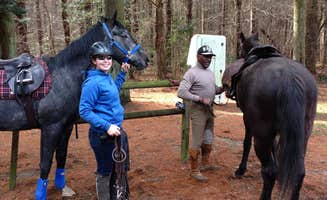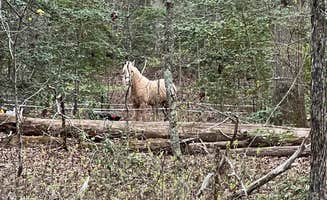Equestrian camping near Fort Howard, Maryland provides access to diverse trail systems across multiple natural areas. The region's gently rolling terrain features a mix of wooded areas and open fields, with elevations typically between 50-300 feet above sea level. Spring and fall offer optimal riding conditions with average temperatures between 55-75°F, while summer months can bring higher humidity and occasional afternoon thunderstorms.
What to do
Trail riding: Lums Pond State Park offers 8 miles of multi-purpose trails around the pond. "Perfect place to hike, bike and picnic!!" notes visitor Ella P. The park maintains well-marked paths suitable for novice to intermediate riders.
Water sports: At Martinak State Park, campers enjoy direct access to the river. "Beautiful waterfront great for kayaking and water sports. No real hiking trails. Overall small quiet campground," reports Laura M. The park features a boat launch with access to a network of water trails.
Fishing: Multiple campgrounds offer fishing opportunities, with Tuckahoe State Park standing out. "You can rent kayaks, canoes and fishing gear. The camp sites are spaced out nicely," shares Jessica K. The park permits fishing in designated areas with a valid Maryland fishing license.
Archery: Cedarville State Forest maintains an archery range for visitors. While currently limited, one reviewer notes, "Playground, fishing, archery all seem blocked off at this time." When open, the range offers targets at various distances suitable for beginners.
What campers like
Spacious sites: At Lums Pond State Park Campground, visitors appreciate the generous spacing. "We arrived to find what seemed like a large field with very few trees," notes one camper. Another adds, "From the moment I pulled in and observed how large the sites were, I was hooked."
Clean facilities: Many campgrounds maintain well-kept restrooms. "The bathhouse is very clean," reports Jessica K. about Tuckahoe State Park. Another camper at Martinak notes, "Campsites and bathrooms are clean. Beautiful waterfront great for kayaking."
Privacy: Blackbird State Forest offers particularly secluded sites. "The camp sites are spaced out a good amount so each site has good privacy," one camper explains. Another adds, "Only 8 sites in the campground, very spaced apart."
Wildlife viewing: The region supports diverse wildlife. One Cedarville camper reports, "Saw a snake, alligator snapping turtle, and rabbits, before we even reached the gates." Horse campers often report deer sightings along trails during early morning rides.
What you should know
Reservation requirements: Most equestrian campgrounds fill quickly, especially on weekends. At Lums Pond, "Book early because it fills up fast!" advises Ellen B. Many campgrounds allow reservations up to six months in advance.
Bug protection: Ticks and mosquitoes can be prevalent, particularly in wooded areas. "LOTS and LOTS of ticks. I got one, but my wife and dog got about a dozen each. Just bring tweezers," warns Ben J. about Cedarville State Forest.
Site selection: Pay attention to site dimensions when booking. At Tuckahoe, one camper cautions, "We booked site 21, blind. The web site does not say site 21 is extremely small. We have a 25' camper, and it barely fit, length and with were an issue."
Water access: Not all sites offer convenient water hookups. "The idea is to use it to fill up tanks. Ranger let us know not to stay hooked up to it," explains one Cedarville camper about nearby spigots. Some parks require filling tanks at central locations.
Tips for camping with families
Playground access: Most parks offer play areas for children. At Martinak State Park, "There's a simple swingset in the loop and a larger, newer playground," reports one visitor. Another notes that Tuckahoe has "a really nice playground for kids (which is separate from the campground)."
Junior Ranger programs: Educational opportunities exist at several parks. One camper shares, "If you're looking to learn and explore with your kids, there is an extensive junior ranger program" at Martinak and Tuckahoe, which are sister parks about 20 minutes apart.
Safety considerations: Most campgrounds have regular ranger patrols. "The ranger was on patrol regularly. We felt very safe!" reports Shanna S. about Martinak. Parents should supervise children around water features, as most parks don't provide lifeguards.
Cabin options: For families new to camping, several parks offer cabin accommodations. "There are 8 camper cabins, 4 on each loop. There are beds for 4 or 6 people, and the cabins have air conditioning, a ceiling fan and electricity," explains Mary S. about Tuckahoe.
Tips from RVers
Dump station quality: Reviews often mention the quality of sanitation facilities. At Tuckahoe, Adam and Suzanne B. note, "Good dump station and potable water fill. Spigots throughout the campground." This allows for convenient tank management.
Site leveling: Many campgrounds feature relatively level sites. "The site was fairly level, side-to-side, so I really only needed to level front to back. That was a bonus," explains one camper at Lums Pond State Park.
Hookup limitations: Not all parks offer full connections. "The campground is wooded and only has electric hookups available," reports Adam and Suzanne B. about Tuckahoe. RVers should plan accordingly for water and sewer needs.
Maneuverability: Some campgrounds have tight access roads or obstacles. "Easy to navigate through with a trailer," notes Rhonda S. about Camp Winery, while another camper at Cedarville warns, "Site 6 was good but not for larger rigs. We have a pop up and had to navigate around a tree that would have been very difficult for larger rigs."



